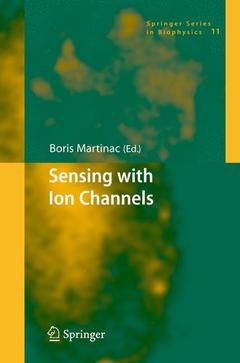Description
Sensing with Ion Channels, 2008
Springer Series in Biophysics Series, Vol. 11
Coordinator: Martinac Boris
Language: English
Subjects for Sensing with Ion Channels:
Publication date: 08-2016
Support: Print on demand
Publication date: 10-2007
304 p. · 15.5x23.5 cm · Hardback
Description
/li>Contents
/li>Biography
/li>Comment
/li>
This is the first book that is not exclusively focused on ion channels functioning in sensory mechanisms that are characteristic of animals and humans, but also describes the role of ion channels in signal transduction mechanisms found in microbial cells and plants. It summarizes comprehensively the progress that has been made in studies of ion channels and their role in sensory physiology.
Boris Martinac graduated in Physics from the Rheinish-Westphalian Technical University in Aachen, Germany in 1976 and received his PhD in Biophysics from the same university in 1980. His doctoral research on ion flux measurements across the cell membrane of a ciliate Paramecium was supervised by Eilo Hildebrand at the Research Centre Jülich. He then did postdoctoral work on electrophysiology of ciliates with Hans Machemer at the Ruhr University in Bochum. From there he moved in 1983 to the laboratory of Ching Kung at the University of Wisconsin, Madison where he used the patch clamp technique to study microbial ion channels. In 1993, he accepted a faculty position in the Department of Pharmacology at the University of Western Australia. In 2005, he moved to the School of Biomedical Sciences at the University of Queensland, Australia where he is a Foundation Professor of Biophysics.
Boris Martinac has earned international reputation as one of the pioneers in characterisation of ion channels in microbial cells. The discovery, cloning and structural and functional characterisation of mechanosensitive ion channels in bacteria present his original contribution to the ion channel research field. He is the recipient of a Fellowship by the French Ministry of Research and Higher Education and an Australian Professorial Fellowship by the Australian Research Council. He served as a President of the Australian Society for Biophysics, and has also served as a member of the Advisory Board of the European Biophysics Journal and as a Corresponding Member for Australia and New Zealand to the Physiological Reviews Editorial Board.
First book which is not exclusively focused on ion channels functioning in sensory mechanisms that are characteristic of animals and humans, but also describes the role of ion channels in signal transduction mechanisms found in microbial cells and plants
Summarizes comprehensively the progress that has been made in studies of ion channels and their role in sensory physiology
Addressing a great variety of sensory mechanisms found in all known types of living cells
Includes supplementary material: sn.pub/extras




